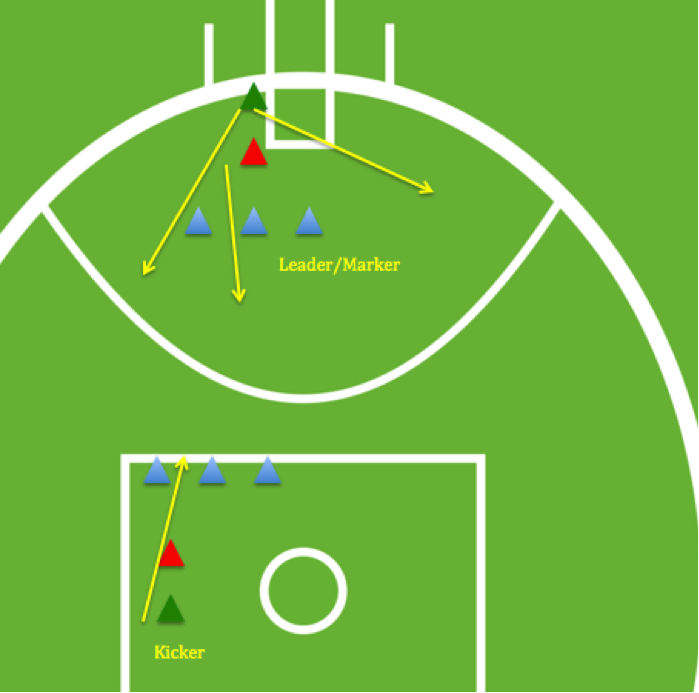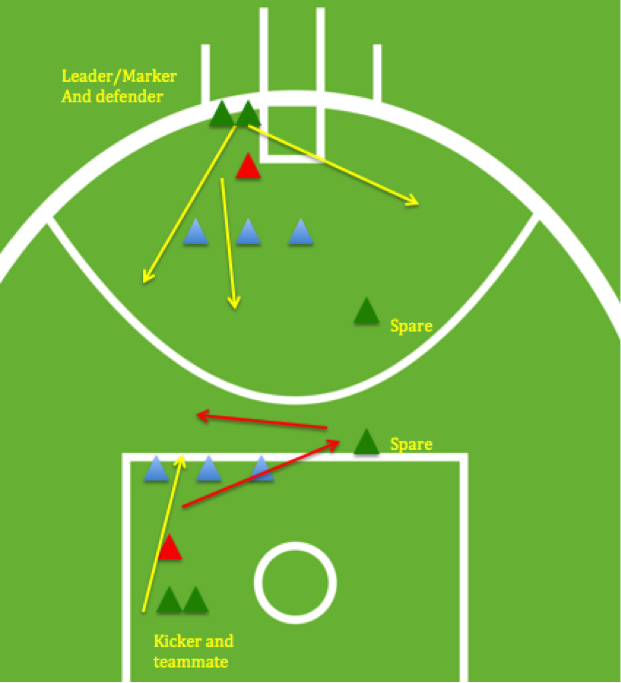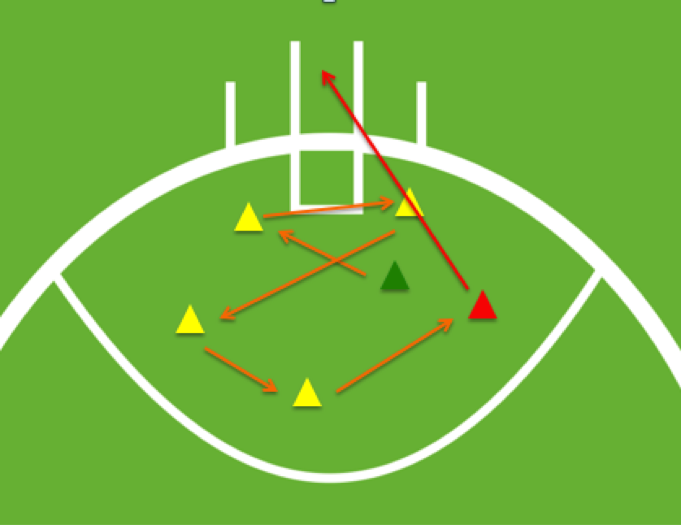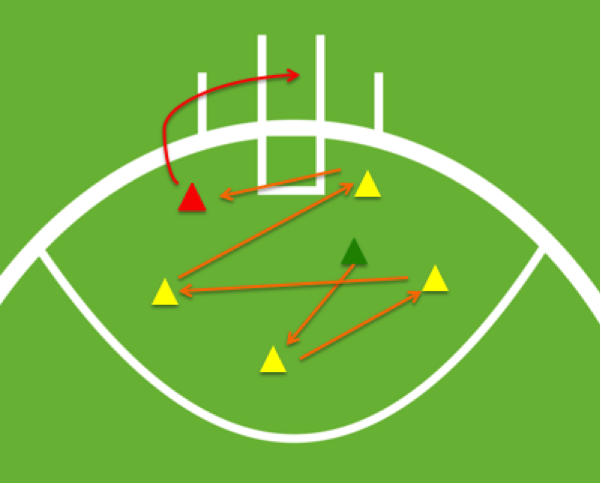Small group (5-6) informal football training
Building on previous discussions looking over various ways of combining speed, agility, direction change and conditioning style work into and/or with football skill-based drills is small private training groups of 2, 3 or 4, we now look at slightly larger group numbers.
As the numbers grow, there are greater opportunities for the conditioning element to be performed in even more football-focused conditions.
As covered previously, what we are looking at here is every bit as much about playing football in an informal setting (in the unfortunate situation many players currently face of having no season, and realistically, no guarantee that next season will be any different), as it is the conditioning element.
As usual, beginning with a pretty standard warm up, before going into some standard closed-chain basic lane work (as previously covered) either in 2 groups of 3 or 3 groups of 2.
However with this growing number of players, 1 lane now also works with things similar to how they would occur in 1-lane amongst group of 30-40 players (3 at each end, handball, kick, extend them back, etc.)
Or to increase the speed, going in 2 players at a time end-to-end, 1 player marking, handball to the other who kicks and both running to the other end (so always 2 players at each end and 2 transporting the ball.)
Another previously covered key point is that all the simple drills and agility, conditioning and speed work that have been previously covered for smaller groups are also great as the numbers increase. These don’t need to change, they can be added in, or abbreviated/tweaked and are still very valuable. But in this discussion we are just looking at different ideas and ways of doing things that aren’t available to you with say only 2 or 3 people.
1.Kick to a lead, accelerate and deliver – Competitive now
We covered a version of this exercise in the discussion on training when there are 2 of you;
-In this version, the player leading now competes with a defender.
-This means that there are 2 players at each end, with 1 or 2 in the middle off to the side resting as well as providing a further option for the kicker.

-Green markers represent 1 player, can be performed with 1 spare player, who moves position depending on what end of the drill the ball is at
-Ball set up on the red cone 5-10 meters ahead of green marker
-1-3 markers set up 15-20 meters ahead of the ball
1.Kicker accelerates from green cone to collect footy at red cone
2.Kicker accelerates with the ball and delivers to leading target
3.Ball MUST be released prior to reaching the blue cones (that is why they are there, to apply time pressure)
4.The leading player can lead whenever they like, and wherever they like (the cones are set up the way they are at that end so that players can reverse roles straight away without swapping positions.)
But;
5.The player leading now has a defender with them who they need to lose/beat by making decoy runs, or just beating with pure speed.
As a result, they now require even better timing and reading of the kicker than the original version of the drill.
6.The player kicking still must release the ball before hitting the blue markers, however if the forward still isn’t free, they have the option of hitting up the spare player (indicated by red arrows) at their end (once again before reaching the blue markers), either with a kick or a 1-2 handball before attempting a delivery to the leader who has hopefully lost their opponent.
7.Repeat the drill back the other way where the kicker and teammate now become the leader and the defender.
8.Repetitions should be worked through at speed, with minimal pauses in between, given that there are spares and rotation will allow for rest times too.
2.Ball feed and quick pass

-3 players at a time, 1 on each yellow marker.
-The player in the middle rolls the ball to the player straight ahead (orange arrow) and then stands the mark
-The player at the top at the same time makes a lead (yellow arrows)
-The player receiving must collect the ball and make a decision and kick execution almost straight away to hit the lead (red)
-Get 2 groups of 3 going, and also add in a conditioning element, where once the kick has been executed (even if it misses the mark) all 3 players turn and sprint 40 meters up to a marker, then sprint back (rotating roles), before getting straight into the next repetition. Have all 3 players perform each role twice before a rest (6 repetitions including 6 sprints.)
3.Set shot goal kick and agility

-1 player completes at a time, 1 standing the mark for the set shot, and another standing behind the goals who starts the timer, times the agility run and also collects the football
-Player begins on green marker, on the signal of the player behind the goals, they complete the agility course as quickly as possible (clock stops when they reach the red marker).
-When they reach the red marker where the player is standing the mark, they are given the ball for a set shot.
-Begin with 2 players behind the goals, 2 on the green marker and 2 standing the mark on the red marker, so the next repetition can begin immediately and rations through can be continuous.
-Complete the circuit 3 times each. Record times, as well as scores.
-Vary the circuit direction, marker locations, and goal shot locations from night to night, but always keep scores.
4.Open play goal kick and agility

-Similar set up to the previous example, begin with 2 players on each of the positions
-Markers are set up in same spots inside the 50, just executed in a different order, and with a different type of shot.
-The same combination of elements involved – agility and a shot at goal, only now involving a snap in open play.
-Player begins their run from the green marker on the signal of the player behind the goal, completing the curse as quickly as possible.
-Once around the final marker (red) they snap the ball around the body. The timer stops once the ball crosses the goal line.
-Once operating smoothly, these can be done very quickly as there is no set shot routine. Complete 5 repetitions each, keep goal scores, as well as time completions.
Additionally;
The basic lane drills that we have covered in earlier articles and that are just the standard common practice immediately after a team warm up, now that there are 5-6 players can also serve to become conditioning focused drills – executed at maximal speed with minimum rest times, and for low repetition counts. It just depends what the focus is on. In the examples we generally only used them as warm up skill-type set-ups. But some training nights can focus on variations on these almost exclusively, just adding in a bit of goal-kicking as well.
You are really only limited by your imagination. Just to reiterate the 3 most important things to ensure a successful setup in this approach to private/informal footy training;
1.Make a commitment to each other, and stick to it – no ‘maybe, when I feel like it, but if I don’t feel like it I will bail’
2.Join in the overall planning together. Bring ideas, discuss them via chat/zoom even – but ensure that when you roll up, everyone knows the general layout of 4-6 drills for the night, preferably for both nights for the week (and on the second night for the week during stretches, decide/map what will do the following week.)
3.Find a way to also add in some competition/record-keeping – the goal-kicking ladder being the simplest thing to keep score of, but even relay races and times as well. And post them in the chat where you have all your discussions.
Onto larger groups of 8-10 next time.
Strength Coach

